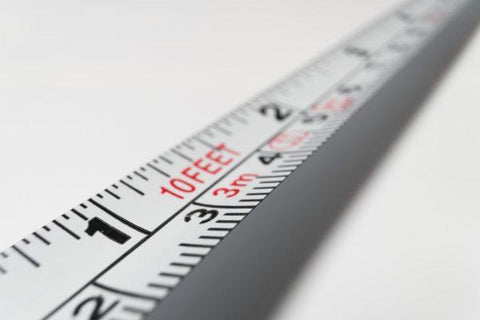
It’s important to get every measurement right when sizing for a wheelchair. A properly fitted chair can make all the difference in combatting discomfort and preventing health issues that arise from extended use, like poor posture, pressure ulcers, discomfort and pelvic and hip problems. The last thing you want is to be leaning to the front, back or side while using your wheelchair.
With all the different functions wheelchairs are designed to perform, their sizing can be different for each category of chair. But before your mind ventures to the great outdoors, start by measuring within your own home. Identify the smallest and narrowest doorways or hallways that may limit your access. Users with wider chairs may be surprised to find obstacles at every turn in their own apartment!
We’ve compiled a list of the ins and outs of wheelchair sizing to help you find the right device. It’s important to note that each measurement may require some additional spacing for wiggle room, comfort, or to make space for baggy clothing. Be sure to sit on a firm surface to take the following measurements:
Seat Height and Width
- Determine seat width by measuring your hips from one end to the other in a straight line. Add 1-2 inches to allow for slight movement and comfort or for bulky clothing. If the seat is too narrow, your weight will fall more on your thighs and create an uneven weight distribution which will affect your spine over time.
- Remaining seated, determine the seat depth by measuring from the back of the hip to the back of the knee. Properly-sized seat depth will offer good posture and reduce ailments of the back and pelvis over time.
- If you need to use your feet to propel yourself, measure the distance from the back of the knee to the heel. The seat height should allow you to reach the floor with your heel.
Armrest Types and Height
Types of armrests:
- Full-length armrests: These are best for someone who frequently performs stand-up pivot transfers. The full-length arm provides the support you need to push yourself to a stand.
- Desk-length armrests: For people who prefer to sit close to a desk or table. The shorter arms allow you to get closer to the surface edge.
Measurement:
- Measuring armrest height: Measure from the elbow to the seat of the chair while you are holding your arm up, elbow bent at a 90-degree angle.
Footrest Style and Height
Types of leg rests:
- Elevating leg rests: If you suffer from edema, swelling or injury, your doctor will mandate you keep your legs elevated at all times. Elevating leg rests lock in place to allow you to extend your legs.
- Articulating leg rests: These are useful for taller people, extending longer than the standard elevating leg rests.
Measurement:
- To determine the length of the footrest, measure the distance from the back of your knee to the heel of your foot. Determining the length of the leg rest extensions influence the seat height. You’ll need a minimum of two-plus inches of clearance from the ground to avoid dragging.
Back Height and Width
- Sitting upright with good posture, measure the distance from your collarbone down to the seat.
- For users with conditions that require additional back support, there are options for higher backrests and even reclining backrests, which doctors may recommend for appropriate weight distribution.
- Chest width: Measure across the chest from one armpit to the other. This determines the width of the seat back.
Weight Considerations
- Wheelchairs are built to accommodate certain weight limits. Make sure you’re selecting a wheelchair that matches your weight to ensure that you fit into it correctly and it provides the support you need.
- If you’ll be folding up your chair while driving or traveling, make sure you select a chair that’s light enough to carry.
Height of grips
- The height of the handgrip should allow a caregiver to bend their elbow slightly and comfortably in pushing the wheelchair.
- The wheelchair’s dimensions should suit the user, so you can take these measurements after you’ve selected the best chair for you. Many companies offer handle extenders for taller caregivers.
Taking these measurements may be difficult to do alone, so get someone to help if you can. All of these measurements are applicable to standard manual wheelchairs. Of course, consult your medical professional to help you research any specific needs you may have for your device and decide which features you want the most.
Once you know your sizing, explore the options available to you. Depending on your needs, a daily chair like Troy’s Economy Plus Wheelchair offers multiple sizing options may help you narrow your search. View the in-depth sizing table to get a sense of typical chair dimensions and how each measurement works with the others in wheelchair construction. With three seat widths to choose from — 16″x 17″ or 18″x 17″ or 20”x 17” — you can get a sense of what options are available on the market today.
Picking out the right wheelchair may be stressful, but every measurement counts when it comes to your extended health. Be patient, do your research and you’ll be sitting in comfort in no time.




